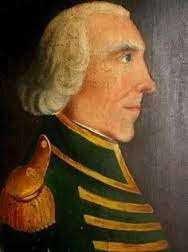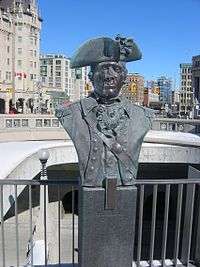John Butler (pioneer)
| John Butler | |
|---|---|
 Portrait of John Butler, date unknown | |
| Born |
1728 New London, Connecticut |
| Died |
13 May 1796 Newark, Upper Canada |
| Allegiance |
|
| Service/branch | British Army |
| Years of service | 1755-1784 |
| Rank | Lieutenant Colonel |
| Unit | Butler's Rangers |
| Battles/wars | |
John Butler (1728–1796) was a Loyalist who led an irregular militia unit known as Butler's Rangers on the northern frontier in the American Revolutionary War. He led Seneca and Cayuga forces in the Saratoga campaign. He later raised and commanded a regiment of rangers. After the war he resettled in Upper Canada, where he was given a grant of land by the Crown for his services.
Early life
John Butler was born to Walter Butler and Deborah Dennison, née Ely, in New London, Connecticut in 1728.[1] In 1742, his father moved the family to Fort Hunter on the frontier in the Mohawk Valley near modern Fonda, New York. In 1752, John Butler married Catharine (Catalyntje) Bradt, of Dutch ancestry. The couple raised five children (two others died in infancy). Having learned several Iroquois and other Indian languages, he was employed as an interpreter, especially in the lucrative fur trade.
French and Indian War
In 1755, John Butler was appointed to the rank of Captain in the Indian Department of the British colonial government. He served in the French and Indian War under Sir William Johnson. In 1758, he saw action with James Abercromby at Fort Ticonderoga and John Bradstreet at the Battle of Fort Frontenac. In 1759, he was made second in command of the Indians with Johnson at the Battle of Fort Niagara. In 1760, he continued as a second in command of the Indians in Jeffery Amherst's force at Montreal.
Pre-American Revolution years
After the war Butler returned to the Mohawk Valley in New York. He acquired more land, building an estate of 26,000 acres (105 km²) at Butlersbury near the major Mohawk village of Caughnawaga. He was second only to Sir William Johnson, British Superintendent of Indian Affairs, as a wealthy frontier land owner, and worked under Johnson for the British. Butler was also appointed a judge in the Tryon County court and was commissioned Lt.-Colonel of Guy Johnson's regiment of Tryon County militia. Butler was elected as one of the two members representing Tryon County in the New York assembly.
American Revolutionary War
John Butler returned to service, as a Loyalist, when the American Revolution turned to war in 1775. In May 1775, he left for Canada in the company of Daniel Claus, Walter Butler, Hon Yost Schuyler and Joseph Brant. On July 7, they reached Fort Oswego and in August, Montreal. Butler participated in the defense of Montreal against an attack led by Ethan Allen. In November, Carleton sent him to Fort Niagara with instructions to keep the Indians neutral.
His oldest son, Walter Butler served with him, but his wife and other children were detained by the American rebels.
In March 1777, John Butler sent a party of about 100 allied Indians to Montreal to force the Americans out of Quebec. In May, Butler received instructions to use a warrior party of the Six Nations in an attack on New York. On June 5 he received instructions to send as many Indians as he could to Fort Oswego for an attack on Fort Stanwix as a part of the Saratoga campaign. He was put second in command of the Indians, under Daniel Claus.
John Butler led the Indians and a small number of Loyalists, in a successful ambush, of rebel militia and Oneida warriors in the Battle of Oriskany. As a result, after this expedition he was commissioned a lieutenant colonel and given authority to raise his own regiment, which became known as Butler's Rangers, initially with a strength of eight companies. He traveled back to Fort Niagara, and completed recruiting the first company in December.
In July 1778, John Butler led his rangers and Iroquois allies at the Battle of Wyoming, in which he defeated Zebulon Butler and took Forty Fort. The Patriots suffered heavy losses, and after the battle Butler's Rangers burned many of the colonists' homes in the area. Later, the battle was referred to as the Wyoming Valley massacre because some of the victorious Loyalists and Iroquois were said to have executed and scalped prisoners and fleeing enemy soldiers.
Later that year, after the burning of Tioga, his son Captain Walter Butler led two companies of rangers and 300 Iroquois allies in a raid which was later referred to as the Cherry Valley massacre. The name of Butler was thereafter anathema to the rebels.
John Butler's unit of rangers was spread, through frontier outposts, from Niagara to Illinois County, Virginia. Butler commanded his rangers, from his headquarters, of Fort Niagara. In 1779, he was defeated, by the Sullivan Expedition, at the Battle of Newtown, and withdrew to Fort Niagara.

Post-war years and death
At the end of the Revolution, John Butler turned to farming in the Niagara region, where he was given a land grant by the Crown for his services during the war. He became one of the political leaders of Upper Canada, later called Ontario. He was appointed as a Deputy Superintendent for the Indian Department, a Justice of the Peace, and the local militia commander. He was also prominent in establishing the Anglican Church and Masonic Order in Ontario.
John Butler died, at his home, in Niagara, Upper Canada, British Canada, British Empire, now present-day Niagara-on-the-Lake, Ontario, on May 12, 1796, at age 68. His wife had died three years prior. Butler was survived by his three sons and daughter. John Butler is interred in the family burial ground in present-day Niagara-on-the-Lake, Ontario.
Legacy
- Col. John Butler School in Niagara-On-The-Lake was named after him, as are numerous other public and private establishments, including a Best Western Hotel, a sports bar, a street leading to the family burial ground on land that was his former property, and the Butler's Barracks National Historic Site, built immediately after the War of 1812.
- In 2006, Lt-Col Butler was honoured by the Canadian Government with a life-sized bronze bust located at the Valiants Memorial in Ottawa. Alongside Joseph Brant, he is considered a key player in the founding of British North America and late eighteenth-century Canada.
- In 2010, a bust was installed on top of a memorial cairn at the site of his homestead on Balmoral Drive in Niagara-on-the-Lake, Ontario.
References
- ↑ Bowler, R. Arthur; Wilson, Bruce G. (1979). "Butler, John". In Halpenny, Francess G. Dictionary of Canadian Biography. IV (1771–1800) (online ed.). University of Toronto Press.
Further reading
- Cruikshank, Ernest, The Story of Butler's Rangers and the Settlement of Niagara, 1893
- The American novelist, Joseph Altsheler referred to John Butler as "Indian Butler" in his 1911 novel about the Wyoming Massacre, The Scouts of the Valley, a story of Wyoming and the Chemung, calling him a turncoat and villain who sided with the Indians against the white settlers. It is available online at the Gutenberg Project.The Scouts of the Valley, a story of Wyoming and the Chemung.
External links
- The Butler papers Brock University Library Digital Repository